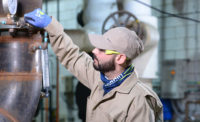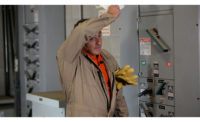When you’re looking to protect workers from a common job hazard, your course is clear. You call your safety sales rep, or maybe even just jump on the internet to look for what you need.
But what if you have a worker with size 16 hands?
Or you have a hazard that’s so out of the ordinary, no one has PPE for it?
This happens more than you might think. It’s actually how many products we now think of as standard got their start. While many safety needs can be met with pre-existing products, there are some situations that need a custom solution.
Hard-to-fit workers
When it comes to safety and to PPE in particular, being unusual can actually be dangerous. Workers who are very large or very small, or workers with differently shaped hands can find it hard to get PPE that fits them properly and provides the protection they need.
PPE manufacturers often get calls from frustrated safety managers trying to find gloves for that petite lady who just started work in their plant or for a larger guy who needs a size 8XL welding jacket.
Rosa Campos, a product design specialist, said she has seen both ends of the spectrum when it comes to size. “We fit people who have hands no glove can fit. Sometimes we have people trace their hand on a piece of paper. We make a glove and send it to them. Then they tell us maybe one part is too tight, one part is too loose. We remake it and send it again.” The product development team even remembers one worker who had to find a bigger piece of paper to trace his hand because the standard 8 ½ x 11 wasn’t big enough.
This process can be especially tricky for workers with hands that differ from four fingers and a thumb. Campos worked with a welder whose hand had a thumb and just one other finger. He was able to handle his welding equipment with expert precision, but was struggling to find a way to protect his hands without the added danger of tacked-down empty glove fingers. “We made him a custom glove that fit perfectly,” she said.
Campos added that they’ve also made gloves for the small end of the spectrum as she worked with an aerospace customer who had a group of smaller women who did spot welding. “We took gloves we already made and created the same thing, only smaller.”
Sending messages via PPE
A new trend manufacturers are seeing: companies want their PPE emblazoned with safety reminder messages, or even just their company logo, to identify what gear belongs to whom. This trend began years ago, but has taken off in the oil and gas construction industry, where it’s common to find several different companies working in close quarters on the same project.
Since it’s not unusual for impact gloves to have very similar looks, safety managers were finding workers accidentally swapping gloves or taking PPE from the wrong company supply. To combat this, they started asking manufacturers if they could make gloves showing their colors and even company logo in a prominent place like the wrist so it would be obvious who was wearing the right gloves. When customers realized that this was easy to do, they started asking for more. Why not add a safety reminder message or a company slogan to help everyone work more safely and feel like part of the team?
Customers found that making gloves unique in this way serves several purposes. Not only does it reduce inventory mixing, but it can also increase compliance, reinforce their safety message, boost brand presence on a job site, and even promote a safety culture.
Challenging safety situations
Perhaps the most common request PPE manufacturers receive is for a product to solve a safety challenge.
Campos said it’s common to find a customer who needs specific protection in just one area of a glove. She said they designed a glove for a metal fabricator who needed the dexterity of a knit glove, but found that workers were getting punctures at the top of the palm just beneath the base of the fingers. They needed a thick leather to protect against this, but making the whole glove out of that material would have been too stiff. She said they made the customer a very specific glove with a knit shell, a latex palm coating, and a leather patch at the trouble point. It looks a little unusual, but it does the job.
Sometimes, solving a safety challenge involves creating something entirely new to go along with protective gloves. Campos recalled a construction company that needed something to protect workers against staple and nail gun hazards. Since a regular glove would obviously not protect against a nail gun, they developed a thick leather hand pad, lined with woven Kevlar and studded with metal. Workers were able to slip the pad onto their hand without removing the gloves they were already wearing. It was the perfect solution to allow them to add protection when they needed it, without encouraging them to remove gloves that protect against other hazards on the job.
For example, sewing specialty sleeves on products such as shirts and protective jackets can also prevent gapping between sleeves and other safety gear so the worker has continuous protection. It even allows them to combine different types of protection, such as sewing cut-resistant sleeves into an FR jacket or vice versa.
Custom requests can add protection while making a product more economical. An automaker had workers who needed a protective apron to guard against contact with abrasive metal parts. The apron was custom-made with a special two-layer pad in the belly area where the workers were rubbing up against the metal. The extra layer was removable, so when the outer pad wore out, they could simply tear it off and add a new pad without needing to replace the whole apron.
If at first you don’t succeed…
New innovations and manufacturing abilities are allowing safety managers to get PPE that fits their people rather than fitting their people to the PPE. So even if you have an unusual safety need and can’t seem to find something that fits, think outside the box. Sometimes the problem is merely the first step to a whole new safety solution.



